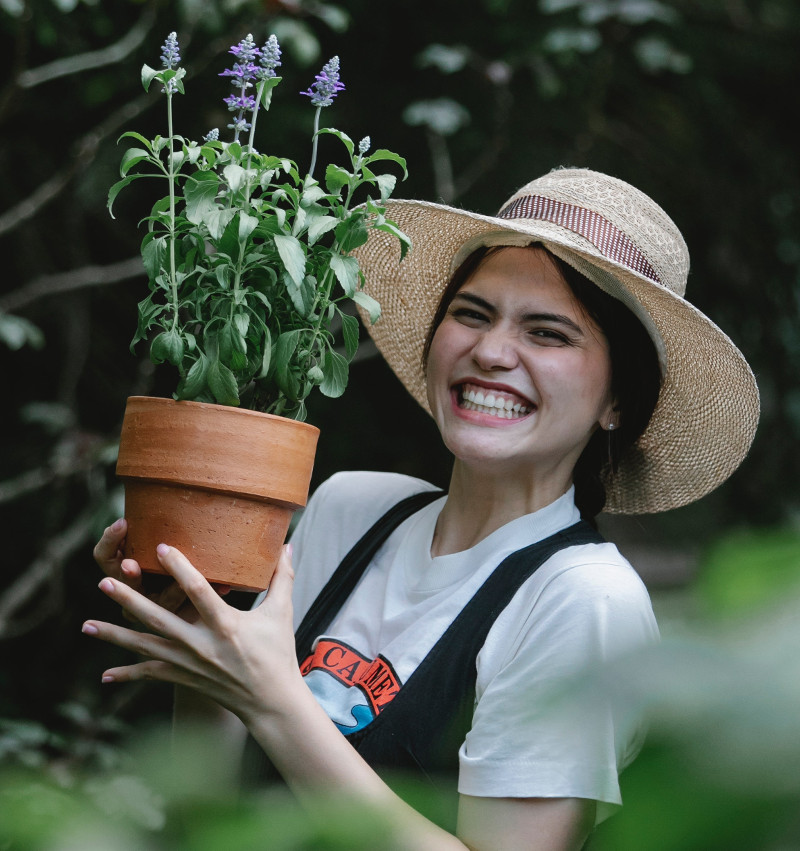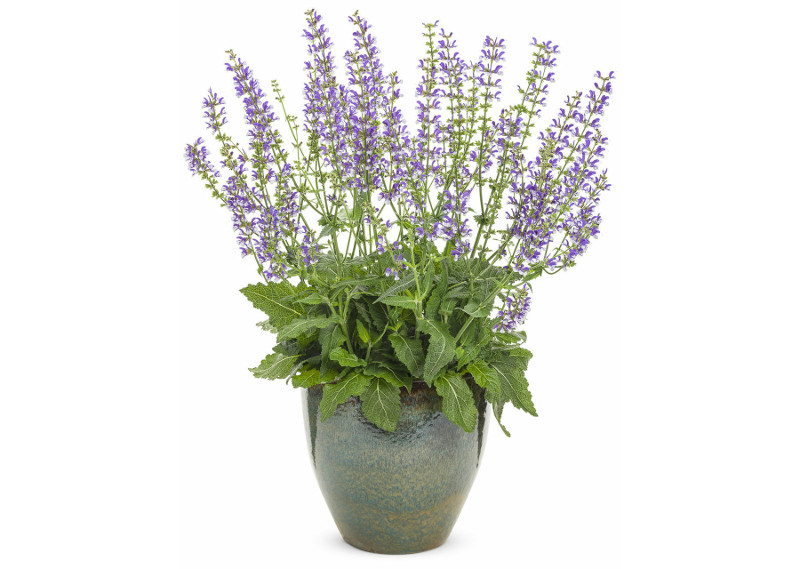Can salvia grow well in pots? Absolutely! Salvia plants are considered thriller additions and are great to add anywhere that receives full sun (6+ hours of sunlight per day). Whether you’d like to add a pop of color on your patio, balcony, deck or sunroom, salvia plants are quite adaptable to growing in pots or planters. Most salvia varieties possess an upright habit, so may not be ideal for hanging baskets as they lack the trailing habit.

Planting Salvia in Pots
Salvia varieties are plentiful and some are annual, while others are perennial. Determine your planting zone and the applicable salvia varieties you wish to plant to determine when is the best time to plant in pots.
Annual salvia varieties such as Rockin'® Blue Suede Shoes Salvia; Saucy Red Salvia; Saucy Wine Salvia; Unplugged® So Blue Salvia; and many more varieties all do well planted in pots outdoors once the last frost has occurred and before the first frost of fall/winter. If you wish to keep annual salvia varieties alive as perennials, bring them indoors to a spot where they will receive full sun. Bring the annual salvia plants back outdoors once the last frost has occurred in early spring.
Perennial salvia varieties such as Color Spires® Indiglo Girl Salvia; Color Spires® Back to the Fuchsia Salvia; Perfect Profusion Salvia; Pink Profusion Salvia and so many more, do well throughout the entire year outdoors. The only time you will need to be wary of planting perennial salvia outdoors is when you are first establishing your new plant. You can start your potted salvia indoors if the weather is on the colder end of the spectrum and bring it outdoors once the danger of frost has passed. Once established, your salvia will thrive and do well with minor maintenance.
Whether you choose annual or perennial varieties of salvia, keep in mind that the best size pot or planter will be at least twice the size of the salvia’s root ball. The chosen pot or planter should have sufficient drainage holes on the bottom of the container to allow water the ability to freely pass through without submerging the roots. Placing a thin layer of small stones at the bottom of the container(s) will provide better drainage. Use a 50/50 ratio of compost and potting soil that has a pH of 5.5 - 6.5 within your chosen container(s).

Best Soil For Salvia in Pots
Salvia plants are quite adaptable and do well in many conditions. With this in mind, for the best results, it is best to start with a basic potting mix and mix with aged compost in a 50/50 ratio. Checking the pH and amending (if needed) to be within the range of 5.5 - 6.5 will provide the best environment for your salvia to thrive and bloom to its heart's desire.
Drainage is quite important, however potted salvia does tend to dry out a bit quicker than in-ground planted salvia. By ensuring your chosen planter has sufficient drainage holes on the bottom, first and foremost, you will eliminate most of the worry of submerged roots. Adding a thin layer of small stones on the very bottom of the container will allow proper drainage.
Mulching your potted salvia plants will ensure to keep the weeds at bay and help retain necessary moisture. You may choose to use pine straw, pine bark nuggets or shredded wood mulch. The type of mulch does not matter too much to the highly adaptable salvia!
Caring For Salvia in Planters
Salvia plants do quite well within containers, whether that may be pots or specific planters. With proper initial planting and occasional maintenance, your salvia will thrive in many areas within your landscape or indoor space. By keeping the soil moist and placing your potted salvia in full sun, you will achieve a healthy and happy plant that will bless you with incredible blooms!
Watering Salvia in Pots
If placed outdoors, your potted salvia will be mostly dependent on rainfall. If your average weekly rainfall is 1” or more, your salvia will be quite happy. If you instead receive less rainfall, check the soil within your potted salvia for moisture and water accordingly.
Indoor potted salvia will need weekly or twice-weekly watering during spring-fall to ensure its roots have the sufficient amount of water needed to thrive. Soak your salvia and allow the excess water to drain away sufficiently. You can successfully monitor your salvia’s water needs by observing the leaves and checking the soil for moisture. During the winter, watering bi-weekly should be sufficient in keeping the roots watered while dormant.
Fertilizing Salvia in Pots
When you first plant your salvia in pots, it is best to create a healthy mix of aged compost and potting mix that will allow your plant the best chance to establish itself within the pot/container. After your salvia has established itself with your chosen container, occasional feeding will greatly benefit your plant as naturally occurring nutrients are less likely within containers. By observing the quality of your salvia’s foliage and/or blooms, you will be able to determine when it is in need of feeding.
To feed your potted salvia, remove any existing soil and add a thin layer of aged compost over the entire root base. Replace the mulch and water thoroughly. Congratulations, feeding your salvia is that easy!
Winter Care For Salvia in Pots
For annual salvia, you will need to bring your plants indoors and place them in partial sun to full shade and water at least once bi-weekly while dormant. Place your annual salvia in a space that will be above freezing to keep your plant alive.
Perennial salvia plants can do well outdoors with a proper sized pot that allows soil space to act as a natural insulator for the roots. Keep in mind that newly potted salvia should be protected from frost and freezes as they establish their new roots. Allow your perennial
Growing Salvia Indoors
Either annual or perennial varieties of salvia can do quite well in indoor planting! Keep in mind that salvia plants soak up the full sun and will need sufficient sunlight to thrive.
Watering salvia that is potted indoors will likely need to be done weekly or twice-weekly. A thorough soak will provide the necessary amount of water needed for your salvia to thrive. To determine your salvia’s watering needs, observe the leaves and/or flowers for any wilting and check the soil to ensure it is moist.
 |
Author Chris Link - Published 03-07-2022 |
